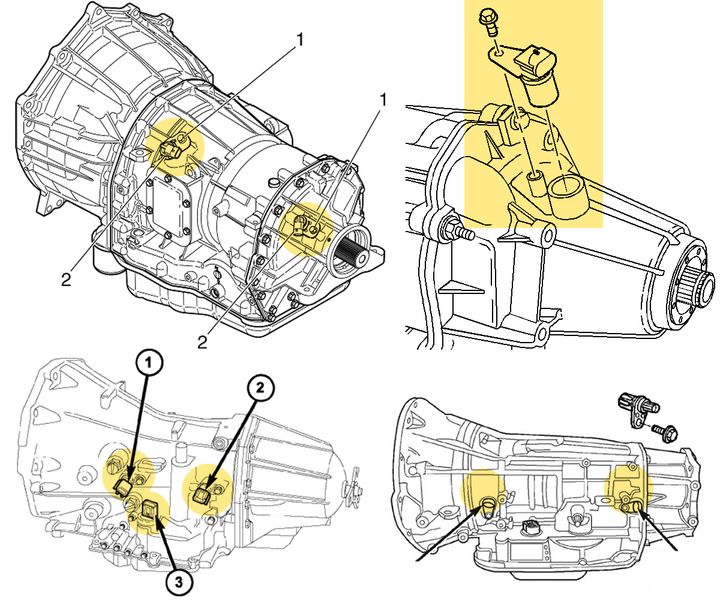


A wheel speed sensor is a crucial component in modern vehicles, responsible for monitoring the rotational speed of each wheel. These sensors play a vital role in various vehicle systems, including the anti-lock braking system (ABS), traction control system (TCS), and electronic stability control (ESC). While their primary function is to ensure proper braking and stability, a faulty wheel speed sensor can also impact the transmission system, leading to various issues and potential damage.

Before we dive into the details, let's first understand what a wheel speed sensor is and its role in the transmission system.
| Component | Function |
|---|---|
| Wheel Speed Sensor | A small sensor located near each wheel hub that detects the rotational speed of the wheels and relays this information to the transmission control module (TCM). |
| Transmission Control Module (TCM) | Uses the data from the wheel speed sensor to determine the appropriate gear ratio and timing for smooth and efficient gear shifts. |
The wheel speed sensor acts as a set of eyes that constantly monitor the wheels' rotation, allowing the transmission to make informed decisions about when and how to shift gears.
There are several common culprits that can lead to wheel speed sensor problems, ultimately affecting the transmission's performance:
Over time, the wheel speed sensor can become damaged or simply wear out due to the harsh operating conditions it endures. Exposure to road debris, moisture, and extreme temperatures can take a toll on this sensitive component. A faulty or damaged sensor will provide inaccurate or inconsistent readings to the TCM, causing erratic shifting behavior, delayed gear changes, or even preventing the transmission from shifting altogether.
The wheel speed sensor is connected to the TCM via a wiring harness. Damaged or corroded wiring, loose connections, or shorts in this harness can lead to inaccurate or intermittent signals being transmitted to the TCM, affecting the transmission's operation.
Another common issue is contamination or debris buildup around the wheel speed sensor. Over time, dirt, metallic particles, or other contaminants can accumulate in the sensor's vicinity, causing it to provide incorrect readings to the TCM, leading to transmission issues.
When a wheel speed sensor is malfunctioning, you may experience one or more of the following symptoms:
Erratic or delayed gear shifts
Transmission slipping or failing to shift gears
Check engine light or transmission warning light illuminated
Reduced fuel efficiency
Abnormal transmission behavior or performance
It's important to note that these symptoms can also be indicative of other transmission-related issues, so proper diagnosis is crucial.
If you suspect a wheel speed sensor issue, the first step is to properly diagnose the problem. Here's how I approach the inspection and diagnosis process:
Using an OBD-II (On-Board Diagnostics) scanner, I check for any diagnostic trouble codes related to the wheel speed sensor or transmission. These codes can provide valuable insights into the nature of the problem and help narrow down the potential causes.
| Code | Description |
|---|---|
| P0720 | Output Speed Sensor Circuit Malfunction |
| P0721 | Output Speed Sensor Range/Performance |
| P0722 | Output Speed Sensor No Signal |
| P0723 | Output Speed Sensor Intermittent |
I physically inspect the wheel speed sensor for any visible signs of damage, corrosion, or loose connections. This hands-on inspection can often reveal obvious issues that may be causing the problem.
I carefully examine the wiring harness connecting the wheel speed sensor to the TCM. Any cuts, abrasions, or signs of damage can indicate a potential wiring issue that needs to be addressed.
In some cases, I may need to perform a resistance test on the wheel speed sensor to ensure it is within the specified range. This test can help determine if the sensor itself is faulty or if the issue lies elsewhere.
| Resistance Range | Condition |
|---|---|
| Within Specifications | Sensor is functioning properly |
| Out of Specifications | Sensor is faulty and needs replacement |
While driving the vehicle, I monitor the live data from the wheel speed sensor to check for any irregularities or inconsistencies in the readings. This real-time monitoring can provide valuable insights into the sensor's performance and help pinpoint intermittent issues.
Once the root cause of the problem has been identified, it's time to address it through proper repair procedures. Here are the common repair methods I employ:
If the wheel speed sensor itself is faulty or damaged, the most straightforward solution is to replace it with a new one. This process typically involves:
Safely lifting the vehicle and removing the wheel assembly
Locating and disconnecting the wheel speed sensor connector
Removing the faulty sensor and replacing it with a new one
Reconnecting the sensor and securing the wiring harness
Reinstalling the wheel assembly and torquing the lug nuts to specifications
In cases where the wiring harness is the culprit, I either repair any damaged or corroded wiring or replace the entire harness if necessary. This process involves:

Locating and repairing any damaged or corroded wiring
Replacing the entire wiring harness if necessary
Ensuring proper routing and secure connections
If contamination or debris buildup is the issue, I thoroughly clean and inspect the sensor mounting area, removing any contaminants that may be causing interference with the sensor's readings.
To minimize the risk of wheel speed sensor issues and ensure the longevity of your transmission system, I recommend following these preventive maintenance practices:
Regularly inspecting and cleaning the wheel speed sensor and surrounding areas can help prevent contamination and debris buildup, which can lead to sensor failure.
As recommended by the manufacturer, periodically replacing the wheel speed sensor can prevent premature failure and ensure accurate readings are being provided to the TCM.
| Vehicle Make/Model | Recommended Replacement Interval |
|---|---|
| Brand A | Every 60,000 miles |
| Brand B | Every 80,000 miles |
| Brand C | Every 100,000 miles |
Maintaining the transmission system by following the recommended fluid change intervals and service schedules can help prevent premature wear and tear on components like the wheel speed sensor.
| Maintenance Task | Recommended Interval |
|---|---|
| Transmission Fluid Change | Every 30,000 - 60,000 miles (consult owner's manual) |
| Transmission Filter Replacement | Every 60,000 - 100,000 miles (consult owner's manual) |
Whenever possible, avoid driving through deep water or excessive mud, as these conditions can introduce contaminants that may affect the wheel speed sensor's performance.
The cost of repairing a wheel speed sensor issue can vary depending on several factors, such as the specific vehicle make and model, as well as the labor rates in your area. Generally, the cost can range from $100 to $400 or more, including parts and labor.
| Cost Component | Typical Range |
|---|---|
| Wheel Speed Sensor (Part) | $50 - $150 |
| Labor Cost | $50 - $250 (or more, depending on complexity) |
It's important to address wheel speed sensor issues promptly, as ignoring them can lead to further transmission damage and potentially more expensive repairs in the long run.
In conclusion, the wheel speed sensor plays a vital role in the proper functioning of your vehicle's transmission system. A faulty or damaged sensor can lead to a range of transmission issues, including erratic shifting behavior, delayed gear changes, or even preventing the transmission from shifting altogether.
By understanding the common causes, diagnostic procedures, repair methods, and preventive maintenance practices, you can take proactive steps to ensure the longevity and optimal performance of your transmission system.
Remember, addressing wheel speed sensor issues promptly is crucial to avoid further transmission damage and costly repairs down the line. If you suspect any issues with your vehicle's transmission or wheel speed sensors, it's always best to consult with a qualified automotive technician for proper diagnosis and repair.
A wheel speed sensor monitors the rotational speed of each wheel and sends this data to the vehicle's computer systems like ABS and traction control. It helps ensure proper braking and stability.
Most modern vehicles have four wheel speed sensors, one for each wheel.
Wheel speed sensors are typically located near the wheel hubs or integrated into the wheel bearing assembly.
Common symptoms include the ABS or traction control warning lights illuminating, erratic speedometer readings, and longer stopping distances.
You can drive, but it is not recommended as the ABS, traction control, and other safety systems will not function properly.
A mechanic will use a scan tool to read diagnostic codes and sensor data, as well as perform resistance and voltage tests on the sensor.
Wheel speed sensors typically last the lifetime of the vehicle but may need replacement if damaged or contaminated.
Common causes include physical damage, contamination, wiring issues, excessive heat, and normal wear over time.
Difficulty varies by vehicle, but often the wheel, brake components, and some suspension parts need to be removed for access.
Replacing it yourself is possible if you have mechanical ability, proper tools and access to the right replacement parts.

Sarah isn't your average gearhead. With a double major in Mechanical Engineering and Automotive Technology, she dived straight into the world of car repair. After 15 years of turning wrenches at dealerships and independent shops, Sarah joined MICDOT to share her expertise and passion for making cars run like new. Her in-depth knowledge and knack for explaining complex issues in simple terms make her a valuable asset to our team.












